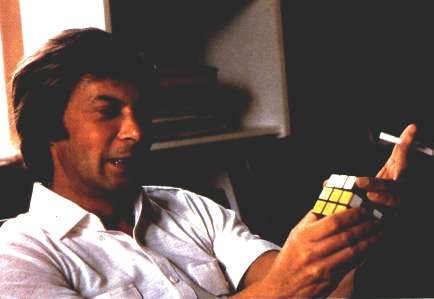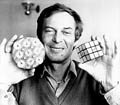
Rubik's cube history |
Information on the Rubik's cube | Ernö Rubik

Born the 13.07.1944, Ernö Rubik created several puzzles of which the most famous is naturally the
Rubik's Cube.
But he also invented a multitude of other brain-teasers as the Rubik's Clock, the Pocket Cube (Rubik's cube 2x2x2)
, ...
| ERNO RUBIK by ERNO RUBIK |
In order to discover him, I suggest you to simply listen to him:
I was born in 1944 in Budapest, Hungary. My father was a mechanic-engineer, glider builder, a renowned specialist, creator of more than twenty six types of gliders. My mother was woman of letters, poetess and artist. The combined presence of these impulses, the technical one and the arts one, haw been for me, I'm sure of it, a determining factor. At first, I tended towards the visual arts : I drew a lot and I have painted a lot. I made my secondary education in a school which was dependent upon the "Beaux- Arts", as a sculptor. From that time, my taste for technical applications awakened. So the next step in my studies naturally became the University of Technical Education of Budapest, and, in 1967, I obtained there my architect diploma.
I still have a passion for architecture, as one have the more complex activities which combines the more characteristic features of science, technical science and arts. With my diploma, I didn't feel yet like a completely well-trained man and I continued my studies at the Decorative Arts High School in the interior architecture section. My second diploma gave me the title of designer; it was given to me in 1970. These studies made me sensitive to the artistic factors. Since 1970 I have stayed constantly in the High School, teaching plans and constructions, interior architecture drawings, furniture plans and projects, study of form and descriptive geometry. Teaching is the best way to learn, I'm still convinced of that; by passing on our knowledge we continue to discover and learn. Moreover, this activity force us each time to a new formulation of what we want to express, force us to new tries, constant search of new methods. The constant links with youth help us to always have a youthful outlook, make us able to surprise ourselves constantly.(...) I got married in 1977; my wife is an interior architect. Our little daughter, born in 1978, is called Anne.
(...)
Space always intrigued me, with its incredibly rich possibilities, space alteration by (architectural) objects, objects transformation in space (sculpture, design), movement in space and in time, their correlation, their repercussion on mankind, the relation between man and space, the object and time. I think the CUBE arose from this interest, from this search for expression and for this always more increased acuteness of these thoughts.(...) I love playing, I admit it, I particularly games where the partner, the real opponent is nature itself, with its really particular but decipherable mysteries. The most exciting game for me is the space game, the search of possible space shapes, that is to say the logical and concrete building of various layouts.
Of course you can't give the exact time of an idea's birth, it seems impossible to me, to me particularly, for who time, from this point of view, has very little interest. It can have been in spring, 1974 that the idea came to me, as a noteworthy possibility. I have a nature attached to experiences, so, since the beginning, I studied variations of a 2x2x2 cube. I was immediately struck by the wealth that could be sensed only from this start. The final technical solution, which is the simplest form 3x3x3, the most easily workable in models, after a few tries, came to me toward the end of autumn, 1974. Several models ready to work were made for me and my friends, it has been exciting to play with them for the first time. We were all surprised to discover gradually that we had made something original, new.
The question of the patent of the invention was immediately raised, so I began the necessary process the 30 January, 1975. Almost at the same, sensing something of the importance of the invented game, of its possibilities and of its real value, I began searching for a partner for the manufacturing and by an extraordinary chance, I indeed found one. The following is rather simple : after its launch on the market (1977) the game became, rapidly and as if by magic, very popular in Hungary, then, from 1980 in the whole world. I feel like the story only begins, and that we can't predict the end, as well as nobody, I think, could have guessed its future.
London, 31 January, 1981, Ernö RUBIK
Translated from Hungarian to French by Paul G. Bozsoky and from French to English by me. Source : "Réussir le Rubik's Cube"(Succeed in solving the Rubik's Cube) by André Warusfel Editions Denoël, 1981
| MISCELLANEOUS |
It took Ernö Rubik 1 month of extensive practice to resolve for the first time its puzzle.
Before, he wasn't even sure that there was a method to succeed.
"This object is a wonderful example of the rigorous beauty, the big wealth of the natural laws :
it is a perfect example of the human mind possibilities to test their scientific rigour and to
dominate them. It represents the unity of real and beautiful, which means for me the same thing."
[Ernö Rubik]
The Cube can seem alive as it heats up in your hand. The fact that each face of the Cube is made of three
layers of three blocks has an important meaning.
The number three seems to have a particular significance, relevant in some strange ways to the relation
between man and nature.
"mother-child-father,
heaven-earth-hell,
creation-preservation-destruction,
birth-life-death."
[Ernö Rubik]
The Cube is an imitation of life itself --or even an improvement on life.
The problems of puzzles are very near the problems of life, our whole life is solving puzzles.
If you are hungry, you have to find something to eat. But everyday problems are very mixed--they're not clear.
The Cube's problem depends just on you. You can solve it independently. But to find happiness in life,
you're not independent. That's the only big difference.
[Ernö Rubik]
